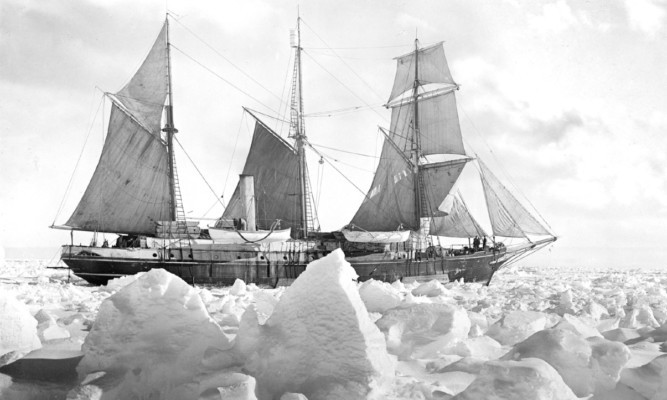As a pupil at Dundee’s Harris Academy in the 1970s, David Crichton Henry would gaze out of his classroom windows and watch boats going up and down the Tay with a sense of wonder.
At a time when he also enjoyed walking at weekends in the Sidlaws, this early connection with the wider world and fascination with Dundee’s polar history through RRS Discovery that instilled in him a sense of adventure that would later take him on adventures around the world.
Now, a century after Sir Ernest Shackleton’s plans to cross Antarctica were dashed on the ice, Mr Henry is helping to lead a new expedition which is set to complete “unfinished business” at the South Pole while honouring Dundee’s historic connection with the golden age of polar exploration.
The Dundee born and raised adventurer is the team historian for a group, which set off on November 25 under the leadership of noted explorer David Hempleman-Adams.
The group plans to walk and ski the final leg of Shackleton’s intended route to the South Pole, arriving on December 15, almost 100 years after Shackleton hoped to do so himself.
They will “man haul” their equipment on sledges in temperatures of -30 to -40c.
The modern expedition, called Endurance South Pole 100, is the initiative of descendants of James Wordie, the Scots geologist and chief scientific officer on Shackleton’s ill-fated trans-Antarctic expedition of 1914-1917.
Mr Henry, 58, now based in Cambridge, is a fellow of the Royal Geographical Society and an accomplished adventurer, having mountaineered in the Rockies and Appalachians.
He told The Courier he is “raring to go”.
“It’s still quite a challenge but nothing compared to the one faced by Shackleton and his men a century ago.
“We have modern equipment and communications. They were lost to the world for two years and faced almost unimaginable hardships before they were eventually rescued.
“So I have nothing but respect for them and their memory. It is a privilege to take part in today’s commemorative expedition.”
Shackleton’s crew was famously forced to abandon their ship the Endurance after it became stuck fast in the grip of the Antarctic pack ice.
Moving from temporary camp to temporary camp, they then drifted with the ice for several months before eventually making landfall on the uninhabited Elephant Island.
From there, Shackleton and five others made a daring, 800-mile sea crossing to South Georgia in one of the ship’s lifeboats, the James Caird.
This was named by Shackleton after Sir James Key Caird, the Dundee jute manufacturer and philanthropist whose sponsorship had helped finance the expedition.
He also funded the building of Dundee’s Caird Hall.
Mr Henry, who works as a surveyor in his day job, said the trip gave him “immense pride” in the heritage of his home city. He added: “Keeping that spirit of discovery going is important.”
Mr Henry said that despite it being mid-summer with 24-hour daylight, temperatures at the pole were likely to plunge way below freezing.
He added: “I’ve done training in the Cairngorms recently but nothing can really prepare you for those conditions.”
James Wordie was one of the crew members left behind, marooned on Elephant Island, where they lived off penguin and seal meat until rescued 138 days later by a returning Shackleton.
Yet for Wordie, these adventures were merely the first chapter in a distinguished career that included eight further polar expeditions, active service in the First World War, an intelligence role during the Second World War and a helping hand in planning the conquest of Everest by Edmund Hillary and Tenzing Norgay.
He eventually become master of his old College, St. John’s, in Cambridge.
The modern Endurance South Pole 100 Expedition is helping honour his place in history by raising funds to establish a digital legacy.
Many of Wordie’s papers are housed in the National Library of Scotland, in Edinburgh. However, his journals from the Shackleton expedition have remained with his family since Wordie died in 1962.
Working with the Scott Polar Research Institute, the aim is to raise enough money to digitise them, making them accessible in full to researchers and historians for the first time.
These remarkably detailed volumes capture the spirit, courage and determination of a group of men trapped in gruelling conditions for nearly two years.
They also include many of Wordie’s scientific notes and environmental observations.
The 14-strong modern team also includes Norwegian explorer Rune Gjeldnes and ex-SAS man and now famous author Andy McNab.
They aim to be home in time for Christmas.
However, Mr Henry hopes it won’t be a white one.
“I’ll be sick of snow by then!” he laughed.
